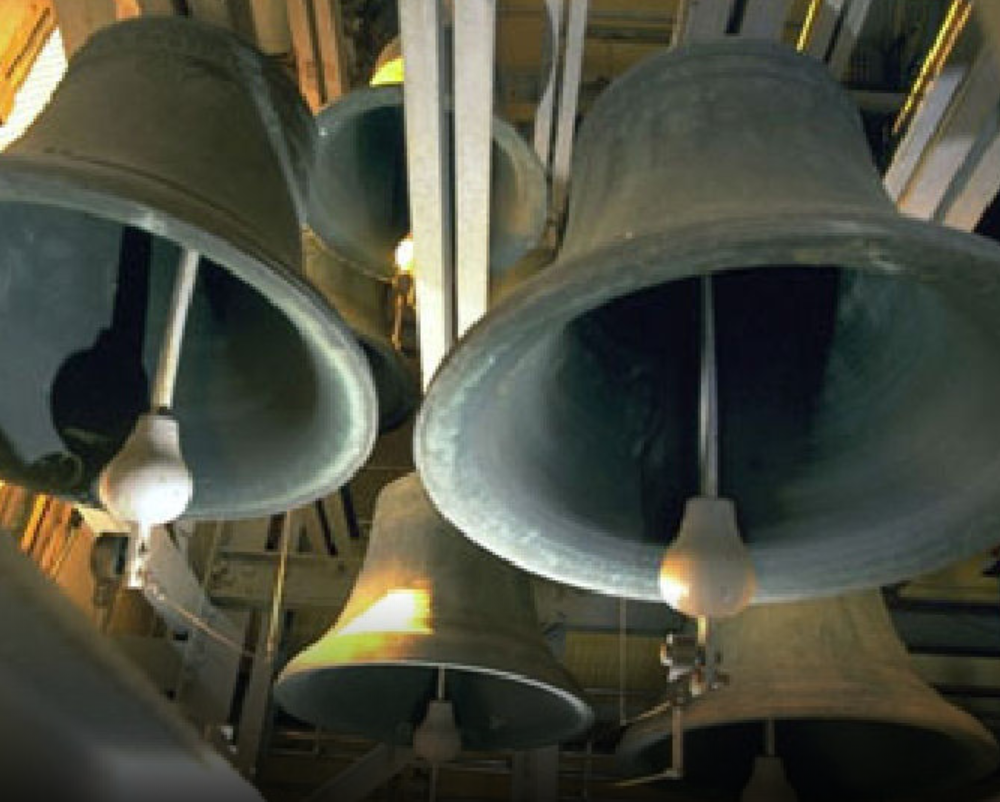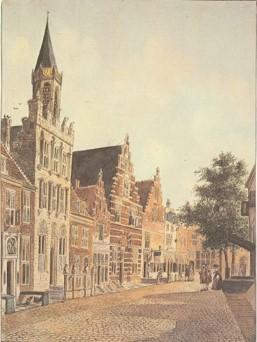
Tholen has the oldest playing carillon clock in the Netherlands
Unique concert instrument with message
“Here comes the bride” or “In a blue checkered smock” are two of those cheerful tunes that can cheer you on as you walk through the city center of Tholen. The harmonious sounds of the carillon carry far, heighten the atmosphere and often proclaim an important message, such as the wedding that is about to be solemnized or the ushering in a national holiday. The carillon is originally an instrument that belongs to the Netherlands and Belgium. At Tholen we own a number of unique carillons/carillons that we are proud of and cherish. We would like to let them hear and provide you with specific information. Starting with the special story of the carillon in the turret of the old town hall of Tholen-stad.
Composition carillon
In this tower hangs a carillon of 37 bells. One of these dates from 1458 and that makes it the oldest playing carillon clock in the Netherlands, cast by the foundry of the Waghevens family in Mechelen. Of the remaining 36, 9 were made by the original bell founder Michael Burgerhuys from Middelburg in 1624, 20 bells by the Royal Bell Foundry Eijsbouts from Asten and the 7 smallest bells were cast by the Royal Bell Foundry Petit & Fritsen from Aarle Rixtel.
History
In the middle of the 16th century a chime sounded over the city of Tholen for the first time. At that time, however, it still hung in the tower of the large church. Around 1590 it was decided to transfer this unique instrument to the tower of the town hall, which motives we do not know, perhaps a better audibility. The tower of the old town hall of Tholen-stad dates from 1452. In 1590 a new clockwork and a new playing drum were put out to tender. And in 1593 there was a chime of 14 bells, cast by the founder Thomas Both, which were fused again less than 40 years later.
In 1627, the Middelburg Gieter Michael Burgerhuys was commissioned to cast a carillon of 18/19 bells and place it in the Stadhuistoren. At that time not a single bell founder was able to produce a clean carillon. If they could have looked into the future, this assignment would have been postponed. The Hemony brothers were able to do that later on. In 1644 Francois and Pieter Hemony tuned the first clean-tuned carillon.
Both in the Netherlands and in Belgium carillon art steadily gained in importance. In the 18th century, Amsterdam and Antwerp were important centers for bell founding. A peak in the carillon culture was around 1750. In the 18th and 19th centuries there was less attention, the intermission of a melody was reduced to one intermission per year. With the French Revolution the carillons were again dealt a heavy blow, many bells were stolen. In 1880 there was an impetus for a turnaround and revival. Partly due to the actions of the Flemish carillonneur Jef Denijn. He was able to convince many that the carillon is a fully-fledged concert instrument after all.
In 1941 another dark period because of the German occupation. The bells were taken out of the tower for the war industry. The Carillons of Tholen, Zierikzee and Brielle could not escape the German bell robbery. However, when the three carillons mentioned were transported by ship across the IJsselmeer, they were sunk. After the war, the ship – appropriately named 'Op Hoop Van Zegen' – was lifted and the three carillons were returned to the municipalities. However, Tholen's carillon went through the Eijsbouts bell foundry in Asten, where it was subjected to an extensive restoration in 1957. The medieval playing drum was also replaced by an electro-magnetic game. The playing drum is now on display in the carillon museum in Asten.
In 1987, Petit & Fritsen in Aarle Rixtel was commissioned to carry out the second and largest renovation phase. The clocks were then disassembled and cleaned. Furthermore, the game has been expanded with two clocks to allow playing a larger repertoire. There are now 37 bells with a total weight of 1.701 kg bell bronze in the turret. A new keyboard has also been purchased that fits better in the space under the carillon in the turret. The playing nature was then greatly improved, with more nuance and dynamics. A successful renovation with which Tholen has managed to preserve a well-playing three-octave concert carillon for the future.
The hand game of the Thoolse carillon
The carillon has been played by hand on a stick keyboard since 1510. Since that time, the carillon has developed into a fully-fledged concert instrument. The carillon is also undoubtedly the largest and heaviest musical instrument in the world. In the attic of the old town hall is a beautiful carillon keyboard. The carillon keyboard consists of a manual or stick keyboard and a pedal or foot keyboard. Each key of the manual or pedal is connected to a clapper via a metal wire. When a key is fully depressed, the clapper strikes the inside of the bell, causing it to sound. You can press multiple tones at the same time, just like on a piano.
Also typical for this instrument is that the carillonneur usually plays with closed hands, the key is pressed by a rotating wrist movement with the fist. The speed and way in which the key is moved determines the dynamics and musicality. There is something wonderful about the sound of the bells, it can evoke a certain mood of the most diverse kind. Think, for example, of the cheerful chiming of a number of bells at the same time. On a holiday, at a funeral, at a summer evening concert and at sunset. Or the mood that the carillonneur conjures up in an hour with the same bells.
Without carillonneurs graduates and amateurs, there is no carillon music. Many carillonneurs are members of the Dutch Glockenspiel Society. Municipal authorities often own the carillons. University boards, church boards and private individuals can also own a carillon. In the Netherlands, the largest and most important bell foundry in the world, the royal bell foundry Eijsbouts in Asten.
The carillon is originally a musical tradition of the low countries. The carillon culture involves more than just a chime that hangs high above the tower. It encompasses the skills of the carillonneurs, the changing repertoire, the tradition of market games and summer evening concerts. Passing on the training as a carillonneur. The role of the carillon as an interpreter of social feelings and evolutions. The carillon tradition is a form of musical heritage that is constantly updated as carillonneurs play the music of our time.
A glockenspiel often hangs in a historic building and is usually located on a street or square where people meet, many chimes take place during the weekly market and on public holidays. The musical instrument carillon also lends itself perfectly to music from non-Western cultures. Moreover, it helps Tholen to profile itself as a region that, on the one hand, honors its own heritage, and on the other it opens up to other cultures. The carillon culture has been recognized as an intangible heritage by UNESCO for some years now.
Carillonneur
Gerard de Waardt has been the municipal carillonneur of Thool since 1976 and plays the carillon in Tholen city as well as in the large church of Sint-Maartensdijk. Get to know Gerard by click here to a short report by Omroep Zeeland from 2017.
Playing times
Fridays on even weeks from 13.00 p.m. to 14.00 p.m. and also on special occasions. During the months of June, July and August, the carillon is played by guest carillonneurs on Saturday afternoons. Come and listen and enjoy this unique instrument.













